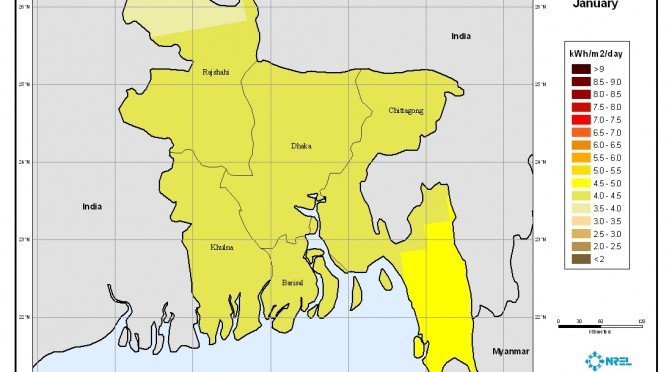The study was conducted by the Bangladesh Environmental Lawyers Association (BELA) and the Coastal Livelihood and Environmental Action Network (CLEAN).

Participants attend a roundtable titled “Renewable Energy: The Path of Sustainability for Bangladesh,” jointly organised by The Business Standard (TBS) and BELA held at the TBS conference room in the capital on Sunday. Photo: Mehedi Hasan
Bangladesh has the potential to generate enough solar energy to meet its entire electricity demand, contrary to the myth of land scarcity, as the country’s untapped Khas land, rooftops, water bodies, and arable land can be used to produce a significant amount of solar power, according to a study.
The study was conducted by the Bangladesh Environmental Lawyers Association (BELA) and the Coastal Livelihood and Environmental Action Network (CLEAN).
The findings were presented today at a roundtable titled “Renewable Energy: The Path of Sustainability for Bangladesh,” jointly organised by The Business Standard (TBS) and BELA. The discussion was moderated by Zahid Newaz Khan, head of digital at TBS.
Presenting the keynote address, Hasan Mehedi, chief executive of CLEAN, said, “The amount of space needed to produce 100% of Bangladesh’s electricity from renewable sources is almost double the current requirement. By using specific portions of Khas land, water bodies, and rooftops, the country can meet its entire electricity demand from renewable sources.”
“While 207,294 acres of space are needed to generate 100% renewable energy, there are currently 402,617 acres available,” he said.
The BELA and CLEAN study, based on GIS mapping, shows that out of over 34.21 lakh acres of Khas land across 61 districts, around 4.03 lakh acres remain unallocated. An average of 38.74% of these lands, around 1.11 lakh acres, could be utilised for ground-mounted solar photovoltaics, capable of generating at least 45,690.23 MW of electricity.
Chattogram division holds the highest potential with 12,271.08 MW, while Sylhet could contribute 1,500 MW, the study finds.
Moreover, Bangladesh’s rooftops cover a total area of 4,712 million square metres. Utilising just 10% of this area, or 471 million square metres, could yield at least 46,644 MW of rooftop solar power. Dhaka division alone could produce 10,779 MW, with Barishal adding another 2,982 MW.
According to the study, utilising 10% of the permanent water bodies, or 63,286.83 acres, could generate at least 21,877 MW. Dhaka again leads with 5,985 MW, while Rangpur offers a minimum of 1,087 MW.
According to the draft Integrated Energy and Power Master Plan, Bangladesh’s power requirement is projected to reach 32,659 MW in 2025, and 84,858 MW in 2050. The government is committed to achieving 10% renewable energy by 2025, and 100% by 2050, as outlined in the 8th Five Year Plan, Nationally Determined Contribution (NDC), Vision 2041, and Mujib Climate Prosperity Plan.
Agrivoltaics, which involves combining agriculture and solar power generation, could also contribute significantly.
Bangladesh has around 11.78 acres of arable Khas land, with 11% used for vegetable gardening (1.30 lakh acres). This land could support 18,099 MW of agrovoltaics, with Rajshahi division leading at 2,640.38 MW and Khulna at the lower end with 1,783.80 MW, according to the findings.
Former Director General of Power Cell, Ministry of Power, Energy, and Mineral Resources, BD Rahmatullah, said the cost of setting up a fossil fuel-based power plant is Tk1,300 crore per 100 MW, whereas renewable energy-based plants cost Tk600-Tk700 crore.
He highlighted the economic and technical viability of renewable energy, despite the lack of political and administrative will.
Dr Fahmida Khatun, executive director of the Centre for Policy Dialogue (CPD), said a significant portion of the national budget is allocated to the power sector, but not specifically to renewable energy.
She stressed that the policies adopted for power generation will heavily influence the economy. Rising fuel prices in the international market lead to higher electricity prices domestically, but price reductions do not reflect in the local market, illustrating a shortcoming in the power management system, she said.
Zakir Hossain Khan, chief executive of Change Initiative, called for a roadmap for power production and renewable energy management.
He suggested imposing a carbon tax of 5% to 10% on fossil fuel imports, which could generate annual revenue of Tk2,060 crore to Tk4,120 crore. Additionally, a 5% pollution tax on companies contributing to plastic production, brick kilns, building construction, water extraction, and forest land clearing could raise Tk2,900 crore, he said.
Zakir Hossain argued that removing import duties on renewable energy components could significantly boost the sector, as a 10% carbon tax alone could generate $0.9 billion.
Syeda Rizwana Hasan, chief executive of BELA, underscored the urgency of enacting the renewable energy Act in Bangladesh. She called for analysing laws and policies from various countries and drafting a law tailored to Bangladesh’s current realities for government consideration.
Dipal Barua, founder and chairman, Bright Green Energy Foundation; also a renewable energy specialist and councillor of the World Future Council, said, “I think the government needs to make a Renewable Power Generation act to facilitate the renewable power generation sector.”
Mohammad Rashedul Alam, assistant director, Sustainable and Renewable Energy Development Authority (SREDA), said, “We need to explore the land for solar, wind and other renewable energy generation.”
Other participants at the roundtable included Dr Sebastian Groh, CEO and co-founder, SOLshare; Lutfor Rahman, executive director and CEO, GreenTech Foundation; Gouranga Nandi, chairman, CEPR; Sheikh Monowar Ahmed, business head, Rahimafrooz; Nawazul Mawla, energy governance coordinator, Transparency International Bangladesh (TIB); and many others.


